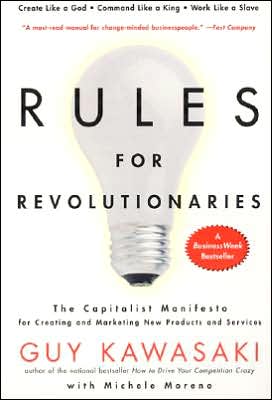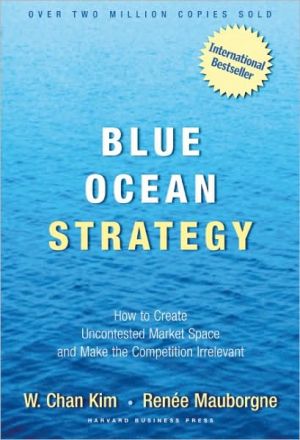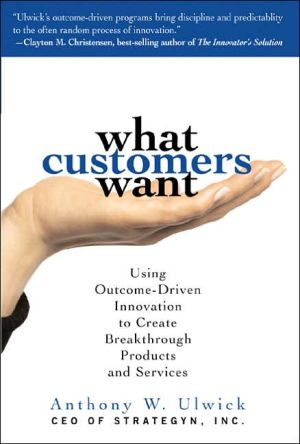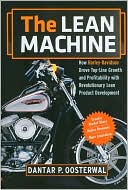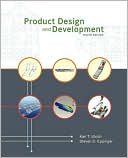Rules for Revolutionaries: The Capitalist Manifesto for Creating and Marketing New Products and Services
Guy Kawasaki, CEO of garage.com and former chief evangelist of Apple Computer, Inc., presents his manifesto for world-changing innovation, using his battle-tested lessons to help revolutionaries become visionaries.\ Create Like a God\ Turn conventional wisdom on its head-create revolutionary products and services by analyzing how to approach the problems at hand.\ Command Like a King\ Take charge and make tough, insightful, and strategic decisions-break down the barriers that prevent product...
Search in google:
Guy Kawasaki, CEO of garage.com and former chief evangelist of Apple Computer, Inc., presents his manifesto for world-changing innovation, using his battle-tested lessons to help revolutionaries become visionaries.Create Like a GodTurn conventional wisdom on its head-create revolutionary products and services by analyzing how to approach the problems at hand.Command Like a KingTake charge and make tough, insightful, and strategic decisions-break down the barriers that prevent product adoption and avoid "death magnets" (the stupid mistakes just about everyone makes).Work Like a SlaveGet ready for hard work, and lots of it. To go from revolutionary to visionary, you'll need to eat like a bird-relentlessly absorbing knowledge about your industry, customers, and competition—and poop like an elephant—spreading the large amount of information and knowledge that you've gained.Filled with insights from top innovators such as Amazon.com, Dell, Hallmark, and Gillette and rich with hands-on experience from the front lines of business, Rules for Revolutionaries will empower you—whether you're an entrepreneur, engineer, inventor, manager, or small business owner—to turn your dreams into reality, your reality into products, and your products into customer magnets. Benjamin M. Rosen The most original, readable, and useful guide to success in business that I've read. . . . Rules for Revolutionaries will become the anthem of our time.
Chapter 8: Think Digital, Act Analog\ Create like a god, screw up like a man, grovel like a dog.\ \ Peter N. Glaskowsky \ Use Technology as a Tool ...\ Thinking digital means using technology to look at real data, track interactions with customers, and mine for information to serve people better. It requires thinking clearly and precisely rather than relying on hearsay, habits, and prejudices.\ Acting analog means using a personal touch. No revolution ever succeeded without a high degree of analog contact - no matter how great your product, how leveraged your marketing, or how coot your Web site. When all is browsed, e-mailed, voice-mailed, and faxed, it's still an analog world.\ The Ritz-Carlton Hotel Company is one of the best examples of using technology to act analog. It has recorded more than 500,000 individual customer requests and preferences in a database system. Once information such as pillow preferences is recorded, guest recognition representatives at all Ritz-Carlton locations can access and act on it.\ The collection of this data is an analog process: "There's an art behind how we do it," says Nadia Kyzer, corporate manager, guest recognition. "We don't ask right out what customers want." It's up to the guest recognition coordinators to chat casually with guests and continually inform staffers of their preferences - especially for the chain's most frequent visitors.\ What's especially important is that Ritz-Carlton uses the power of digital technology to enhance, not supplant, a personal relationship. Similarly, Peapod Inc., the online grocery shopping service, knows which items customers usually buy and presents them with this personal information to speed the shopping process. Digital technology - computers, databases, and networks - makes this possible.\ (I love hotel examples. Here's another instance of good analog behavior: the Little Nell Hotel in Aspen, Colorado. Its concierges call guests at least two weeks before they arrive in order to answer questions, make restaurant reservations, and arrange for transportation.' This is acting analog!)\ ... But Use Technology Carefully\ Great as it can be, digital technology can also create negative feelings by invading people's privacy or simply being a pain in the ass. I hate it, for example, when I buy a $2 battery at Radio Shack, and the clerk asks my name and address so that Radio Shack can do "relationship marketing" with me.\ Digital power is easy to abuse, so keep these two principles in mind when you're thinking digital (the next chapter, "Don't Ask People to Do Something That You Wouldn't" covers this general topic in greater detail).\ First, never require customers to give you, personal information. The information might be crucial for your database and direct marketing efforts, but that's your problem, not your customers'. Has a sales clerk at Nordstrom (the most analog of retailers) ever asked for your name and address?\ The best kind of data collection is done without intervention at all. When I visit Amazon.com's Web site, the company suggests books, for me to purchase by reviewing my account history. By contrast, I've been flying on United Airlines for years (at the rate of about 100,000 miles), and every time I call, I still have to ask for an aisle seat and a fruit platter.\ Second, use the information judiciously. If your customers are willing to give you this information, use it but use it judiciously. That is, don't inundate them with marketing and sales crap.\ Third, don't collect information if you're not going to do something with it. Bombarding customers with useless advertisements, in fact, maybe be less heinous than collecting scads of information just so you can "have it on hand."\ Ideally, you and your customers should both derive value from the information they provide. Short of this, at least your customers should get some value. But if it's only you that derives value, then you're hassling your customers for insufficient reason. Being a customer of your company should never entail the burden of being mere data for your research projects.\ EXERCISE\ If Ritz-Carlton started an airline, would you fly on it?\ Extra credit: Would this airline ask you twice what type of seat and food you'd like?\ Identify the Right Decision-Makers\ Revolutionaries often make three key mistakes at the start of a revolution when they start marketing and evangelizing their product: First, thinking that someone can make a decision when they can't. In 1983 and 1984 Apple came up with a typical yuppie, yellow-paisley- tie-MBA, digital analysis:\ Macintosh is a business computer, and businesses look up to Fortune 500 companies. Fortune 500 companies are run by presidents, vice-presidents, and MIS directors. These folks have the titles, therefore they have the power. Let's sell them on Macintosh, and they will make topdown decisions to put Macintoshes in their companies.\ This strategy sold five Macintoshes. The executives, by and large, either couldn't make the decision or didn't want to. They that last ten years or more. When we first started, we got these types of mid-range projects with people just trying to save monthly operational dollars."\ Once these contractors started using preserved plants, the idea became accepted, and landscape architects began considering Gabrick's service. Gabrick knew he could save a building owner or developer the major expense of accommodating live plants, but instead of targeting them directly, he focused on the landscape architects who had a lot to gain by taking credit for saving money on a project.\ Identifying the right decision-makers is an analog process. There usually isn't a single person who can make a unilateral yes/no decision. Instead there are usually several people who can help your revolution, and they, in turn, are influenced by many others.\ Ignore People's Titles\ As the Macintosh introduction experience showed, one of the biggest barriers to identifying the decision-maker is paying too much attention to people's titles.\ Here's a nonbusiness story to illustrate the concept. One of the subscribers to the Rules for Revolutionaries Internet mailing list found himself deposited in front of twenty-two Siberian Yupik seventh and eighth graders in an Eskimo village in rural Alaska. In an Eskimo village, the climate and living conditions are so harsh that teacher turnover is often 100 percent per year. To the locals, school staff is often little more than an ever changing parade of clowns.\ The teacher realized that his Eskimo aide was the one constant in his student's educational lives. Instead of telling the aide what to do, this teacher picked his brain and the brains of the entire non-teaching staff. Teaching is a fairly hierarchical profession, so it's unusual to seek the counsel of those below you on the ladder, especially when they might not have even a high school education and they speak broken English.\ In this case, these very people saved him from many mistakes, however, and established the tone of his relationship with parents all around the village. His students were mysteriously better behaved. The word got out that he was respectful of them because he ignored the humble titles of the "aides" during the first few weeks of school, so they became more respectful of him.\ Highfalutin titles don't mean a person is knowledgeable and powerful, and humble titles don't mean a person is dumb and powerless. Big titles mean little to a revolutionary. All you care is about is that a person "gets it" and wants to help you.\ Ignoring people's titles also means ignoring the titles of your own employees. That is, don't limit personal contact to employees who usually work with customers-instead, let the whole company in on the fun, You will impress customers if employees of all kinds, not just the ones whose job is "customer service," are helping them. And employees will learn more about customers and better serve them.\ In Best Practices, Robert Hiebler, Thomas Kelly, and Charles Ketteman discuss a United Airlines employee named Patricia O'Brien Saari. Saari is an account executive in United's Seattle office, and she started a volunteer program called "100,000 Miles of Thanks." Employees in various positions wrote to 100,000-mile frequent flyers thanking them for their business and reminding them to take advantage of the special perks of 100,000-mile flyers.\ This is a beautiful illustration of thinking digital and acting analog: United's computers tracked their most frequent flyers, but United's employees took the analog step of sending them letters which increased their loyalty to the airline.\ Show Up in Person\ You can dream, create, design, and build the most beautiful place in the world, but it requires people to make it reality...
Acknowledgements ..... xiiiForeword ..... xv Create Like a God Chapter 1: Cogita Differenter (Think Different) ..... 3Chapter 2: Don't Worry, Be Crappy ..... 23Chapter 3: Churn, Baby, Churn ..... 46 Command Like a King Chapter 4: Break Down the Barriers ..... 67Chapter 5: Make Evangelists, Not Sales ..... 82Chapter 6: Avoid Death Magnets ..... 94 Work Like a Slave Chapter 7: Eat Like a Bird, Poop Like an Elephant ..... 113Chapter 8: Think Digital, Act Analog ..... 133Chapter 9: Don't Ask People to Do Something that You Wouldn't ..... 148 Conclusion Chapter 10: Don't Let Bozosity Grind You Down (Ne Te Terant Molarii) ..... 161 List of Works Used ..... 181Notes ..... 187Index ..... 197
\ Brad Wieners[Kawasaki] offers three imperatives, shares 10 chapters of advice and exercises, and includes such bong-headed silliness as "Flow with the Go." Dude. \ —Wired\ \ \ \ \ Benjamin M. RosenThe most original, readable, and useful guide to success in business that I've read. . . . Rules for Revolutionaries will become the anthem of our time.\ \ \ Business 2.0Rules, which teaches would-be innovators how to expand the status quo and succeed in the process, is an easy and entertaining read full of commonsense guidelines, mind-expanding exercises, and down-to-earth aphorisms.\ \ \ \ \ From The CriticsGuy Kawasaki's Rules for Revolutionaries isn't just about high-tech. It's not even just about business. At its most inspirational, it's a primer for living, a kick in the pants that screams "don't let Bozosity grind you down."\ Advice like this is the author's stock in trade. Kawasaki is the former chief evangelist for Apple and is now the founder of Garage.com, a Silicon Valley-based firm that helps start-ups find seed money.\ His book is less a how-to manual than a how-to-think guide, sprinkled with such "exercises" as: "Access your Web site via a 28.8K modem. Extra credit: Access your Web site via America Online and 28.8K modem."\ Some of Kawasaki's ideas ("churn, baby, churn"; "think digital, act analog"; "eat like a bird, poop like an elephant") may seem off-the-cuff, but they are heavily referenced, gleaned from keen observation and illustrated with examples that range from the Wright brothers to the Grateful Dead.\ Even if you have no interest in revolutionizing anything, Rules for Revolutionaries is worth the price of purchase for these tidbits alone. After all, they just might come in handy at your next VC cocktail party.\ \ \ \ \ \ Brad Wieners[Kawasaki] offers three imperatives, shares 10 chapters of advice and exercises, and includes such bong-headed silliness as "Flow with the Go." Dude. \ —Wired\ \ \ \ \ Michael YamRules For Revolutionaries \ As if revolutionaries really followed rules, Guy Kawasaki puts forth a top 10 list for aspiring entrepreneurs in his book Rules for Revolutionaries: The Capitalist Manifesto for Creating and Marketing New Products and Services. Still, the result is a fun combination of counter-intuitive advice (Rule #2: Don't Worry, Be Crappy) and rather obvious advice (Rule #9: Don't Ask People To Do Something That You Wouldn't).\ Kawasaki writes with humor and irreverence, drawing on his own experiences and the experiences of other companies and individuals. Elaborating on Rule #2, he describes how he helped ship what he now calls a crappy product in 1984, the first Macintosh Personal Computer. He writes that the Mac had a host of shortcomings, notably only 128K of RAM, no hard disk, and no color display. But Kawasaki's point was don't stay crappy. He writes that "revolutionary products don't fail because they are shipped too early. They fail because they aren't revised fast enough."\ In a later chapter, Kawasaki holds up Microsoft as a company that has mastered the art of revision.\ Regarding Rule #9, although obvious, revolutionaries still need to be reminded of it. Kawasaki relates how a California bank took telemarketing beyond rudeness; it would automatically dial people at home, but when they picked up, they would be put on hold until a sales representative was available.\ Kawasaki's thesis is based on the acronym "DICEE." It describes great products and services as "Deep, Indulging, Complete, Elegant, and Evocative." The Breitling Aerospace watch is an example of a DICEE product (pages 24-25):\ "Great products are deep. Their features and functions satisfy desires that you didn't know you had at the time of purchase. The mark of a deep product is wishing it had a feature after you've used it for a while and then discovering that it already does. \ "Deep products grow with you, so you don't have to buy another product soon thereafter. Indeed, a savvy consumer will buy a product or service that, though too deep initially, will allow for the future growth as the user becomes more sophisticated.\ "My favorite example of a deep product is a watch called the Breitling Aerospace. On one level, it's merely a watch with hands and numerals, but over time you come to learn of its depth: the ability to let you tell time with analog hands or digits, see what time it is in at least two other time zones, determine how much longer an airplane flight should last, and figure out long you've been jogging."\ \ Kawasaki adds in a humorous footnote that the watch may be too deep:\ "The Breitling Aerospace has one feature, however, that I cannot figure out when to use. If you press the crown, it uses four different tones to tell you what time it is. I guess you could be trapped while spelunking, unable to turn your wrist to look at the luminescent dial, but able to press down the crown with your other hand. This feature will then enable you to hear what time it is before you die."\ To complete but oversimplify the explanation of DICEE, indulging products pamper, complete products have well-rounded post-sales support, elegant products are aesthetically pleasing and easy to use despite their depth, and evocative products elicit a strong emotional response. One thing that detracted from the book was the poor quality paper. It was thin enough so that I could make out text and images on the other side. In this regard, the book was not a DICEE product because it failed to be indulging.\ Because Kawasaki also relies on the experiences of others, the book is heavily footnoted to the point of distraction. For example, every company mentioned had a footnote indicating its web site. While useful for lesser known firms, seeing a reference to Disney footnoted with "http://www.disney.com/" felt redundant. The reader would be better served if these annotations were placed in an appendix. Mercifully, the information from individual contributors appeared in a "Notes" chapter at the end of the book.\ Despite the copious footnotes, Kawasaki failed to annotate his mention of the Hawthorne Effect. It was a topic I wanted to learn more about, but he simply glossed over it as a study conducted in the 1920s where researchers believed the mere act of watching workers made them increase output. As applied to marketing, Kawasaki's point was that although it is important to watch consumer behavior, if consumers knew they were being watched, that awareness would alter their choices.\ Nevertheless, a little research of my own revealed the Hawthorne Effect to be a flawed study. In the New York Times (12/6/98), "Scientific Myths That Are Too Good To Die," Gina Kolata writes that only five workers took part in the study and two were replaced part way for gross insubordination and low output.\ Kawasaki may have misapplied the Hawthorne Effect, but his words about watching consumers still ring true.\ Kawasaki infuses the book with accounts of personal successes and failures, but he also draws on an equal amount of knowledge from secondary sources. Thus, this book should appeal to relatively new revolutionaries like myself, whereas battle-scarred revolutionaries might see some of the material as rehashed. Still, I give the book high marks for its perceptiveness, humor, and inspiration.\ — Dr. Dobb's Electronic Review of Computer Books\ \ \
